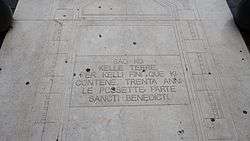Placiti Cassinesi
The Placiti Cassinesi are four official juridical documents written between 960 and 963 in southern Italy, regarding a dispute on several lands among three Benedictine monasteries and a local landowner. They are considered the first extant documents written in a Romance vernacular of Italy, along with the Veronese Riddle.[1]
| Placiti Cassinesi | |
|---|---|
 Marble inscription of one of the placiti in the town of Capua. | |
| Language | Italian |
| Date | 960-963 |
| Provenance | Monte Cassino, Italy |
| Manuscript(s) | 4 |
| Genre | Juridical document |
| Subject | Resolution of a property dispute |
| This article is part of the series on the |
| Italian language |
|---|
| History |
| Literature and other |
| Grammar |
| Alphabet |
| Phonology |
Text
Original text:
- Sao ko kelle terre, per kelle fini que ki contene, trenta anni le possette parte Sancti Benedicti. Capua, Marzo 960
- Sao cco kelle terre, per kelle fini que tebe monstrai, Pergoaldi foro, que ki contene, et trenta anni le possette. Sessa, Marzo 963
- Kella terra, per kelle fini que bobe mostrai, sancte Marie è, et trenta anni la posset parte sancte Marie. Teano, Luglio 963
- Sao cco kelle terre, per kelle fini que tebe mostrai, trenta anni le possette parte sancte Marie. Teano, Ottobre 963[2]
Latin (word-for-word):
- Sapio quod eccelle terre, per eccellas fines quas eccic continet, triginta annis illas possedit pars Sancti Benedicti. Capua, Martius 960
- Sapio quod eccelle terre, per eccellas fines quas tibi monstravi, Pergoaldi fuerunt, quas eccic continet, et triginta annis illas possedit. Suessa, Martius 963
- Eccella terra, per eccellas fines quas vobis monstravi, sanctae Mariae est, et triginta annis illam possedit pars sanctae Mariae. Teanum, Julius 963
- Sapio quod eccelle terre, per eccellas fines quas tibi monstravi, triginta annis illas possedit pars sanctae Mariae. Teanum, October 963
Modern Italian:
- So che quelle terre per quei confini che qui sono contenuti trent'anni le possedette la parte di San Benedetto. Capua, Marzo 960
- So che quelle terre, per quei confini che ti mostrai, furono di Pergolardo, e qui sono contenuti e per trent'anni li possedette. Sessa, Marzo 963
- Quella terra per quei confini che a voi mostrai è di Santa Maria e per trent'anni la possedette la parte di Santa Maria. Teano, Luglio 963
- So che quelle terre per quei confini che ti mostrai per trent'anni le possedette la parte di Santa Maria. Teano, Ottobre 963
Translated:
- I know those lands, whose borders are shown in the map, have been owned by St. Benedict's region for thirty years. Capua, March 960
- I know those lands, whose borders I have shown you, were property of Pergoald, and here are part of, and it has owned them for thirty years. Sessa, March 963
- That land, whose borders I have shown you, is property of St. Mary, and St. Mary's region has owned it for thirty years. Teano, July 963
- I know those lands, whose borders I have shown you, have been owned by St. Mary for thirty years. Teano, October 963
Explanation
The documents called "placiti" (placito means judge's opinion) are a group of four parchments and were discovered by Erasmo Gattola in the benedectine monastery of Monte Cassino, about 130 kilometres (81 mi) southeast of Rome, in the 1700s. The documents are a resolution of a dispute on the property of several lands located in the Italian cities of Capua, Sessa Aurunca and Teano, between three monasteries owned by Monte Cassino and Rodelgrimo d'Aquino, a local landowner. With these documents, after the deposition of three witnesses, the judge clearly stated that the three monasteries were the legitimate owners of the lands.[3]
See also
- Latin language
- Romance languages
- Italian language
References
- "LA LINGUA ITALIANA". multimediadidattica.it. Archived from the original on 2006-05-07. Retrieved 2014-03-12.
- "bibliotheca Augustana". hs-augsburg.de. Retrieved 2014-03-12.
- "PLACITI CASSINESI". veranigrisoli.altervista.org. Retrieved 2014-03-12.